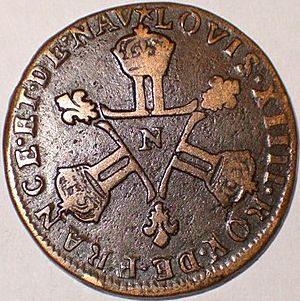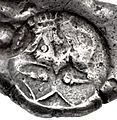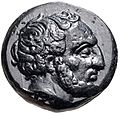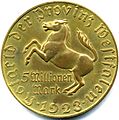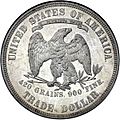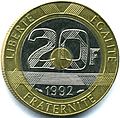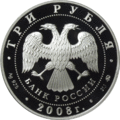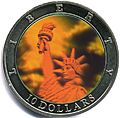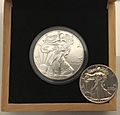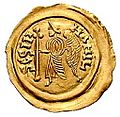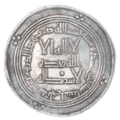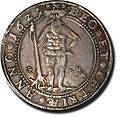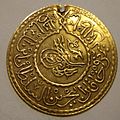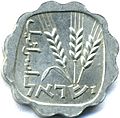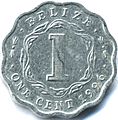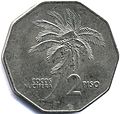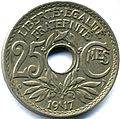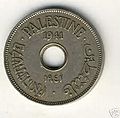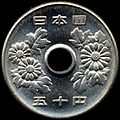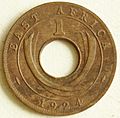Coin facts for kids
A coin is a small, flat, round piece of metal or plastic used primarily as a medium of exchange or legal tender. They are standardized in weight, and produced in large quantities at a mint in order to facilitate trade. They are most often issued by a government.
Coins are usually metal or alloy, or sometimes made of synthetic materials. They are usually disc shaped, they have been made for about 2600 years; the first place to make coins was Lydia (modern Turkey).
Most people use coins as currency. They usually have lower value than banknotes.
In the last hundred years, the face value of circulation coins has occasionally been lower than the value of the metal they contain, for example due to inflation. If the difference becomes significant, the issuing authority may decide to withdraw these coins from circulation, possibly issuing new equivalents with a different composition.
Contents
History
The first coins were developed independently in Iron Age Anatolia and Archaic Greece, India and China around the 7th and 6th centuries BCE. Coins spread rapidly in the 6th and 5th centuries BCE, throughout Greece and Persia, and further to the Balkans.
The first circulating United States coins were cents (pennies), produced in 1793, and made entirely from copper. Silver content was reduced in many coins in the 19th century (use of billon), and the first coins made entirely of base metal (e.g. nickel, cupronickel, aluminium bronze), representing values higher than the value of their metal, were minted in the mid 19th century.
Appearance
Many coins have unique or complicated decorations; one side often has the picture of a famous or important person's head on it.
The side of a coin carrying an image of a monarch or other authority, or a national emblem, is usually called the obverse, or colloquially, heads; see also List of people on coins. The other side, which may carry the denomination, is usually called the reverse, or colloquially, tails.
Many coins over the years have been manufactured with integrated holes such as Chinese "cash" coins, Japanese coins, Colonial French coins, etc. This may have been done to permit their being strung on cords, to facilitate storage and being carried, etc.
Collecting
Because coins have been made for a very long time, some people collect old coins. They can be much cheaper than other old things, especially if they are made of cheap metals like copper. Older coins normally cost more than newer ones, but rarity matters more-some coins from the 1920s cost vast sums, while some Roman coins cost very little.
The Royal Canadian Mint is now able to produce holographic-effect gold and silver coinage. However, this procedure is not limited to only bullion or commemorative coinage. The 500 yen coin from Japan was subject to a massive amount of counterfeiting. The Japanese government in response produced a circulatory coin with a holographic image.
The Royal Canadian Mint has also released several coins that are coloured, the first of which was in commemoration of Remembrance Day. The subject was a coloured poppy on the reverse of a 25 cent piece.
For a list of many pure metallic elements and their alloys which have been used in actual circulation coins and for trial experiments, see coinage metals.
Physics and chemistry
Flipping
Coins are popularly used as a sort of two-sided dice; in order to choose between two options with a random possibility, one choice will be labeled heads and the other tails, and a coin will be flipped or tossed to see whether the heads or tails side comes up on top – see coin flipping. Mathematically, this is known as a Bernoulli trial.
Spinning
Coins can also be spun on a flat surface such as a table. This results in the following phenomenon: as the coin falls over and rolls on its edge, it spins faster and faster. This is mathematically modeled as a finite-time singularity – the precession rate is accelerating to infinity, before it suddenly stops, and has been studied using high speed photography and devices such as Euler's Disk.
Odor
Iron and copper coins have a characteristic metallic smell that is produced upon contact with oils in the skin. Perspiration is chemically reduced upon contact with these metals, which causes the skin oils to decompose, forming with iron the volatile molecule 1-octen-3-one.
Images for kids
-
An oxhide ingot from Crete. Late Bronze Age metal ingots were given standard shapes, such as the shape of an "ox-hide", suggesting that they represented standardized values.
-
Silver stater of Aegina, 550–530 BCE. Obv. Sea turtle with large pellets down centre. Rev. incuse square punch with eight sections.
-
Athens coin (circa 500/490–485 BCE) discovered in the Shaikhan Dehri hoard in Pushkalavati, Ancient India. This coin is the earliest known example of its type to be found so far east.
-
The Achaemenid Empire Satraps and Dynasts in Asia Minor developed the usage of portraiture from circa 420 BCE. Portrait of the Satrap of Lydia, Tissaphernes (c.445–395 BCE).
-
Hoard of mostly Mauryan Empire coins, 3rd century BCE.
-
Chinese round coins, Eastern Zhou dynasty – Warring States Period. Circa 300–220 BCE. Four Hua (四化, 30mm, 6.94 g). Legend Yi Si Hua ([City of] Yi Four Hua).
-
Posthumous Alexander the Great tetradrachm from Temnos, Aeolis. Dated 188–170 BCE. Obverse: Alexander the Great as Herakles facing right wearing the nemean lionskin. Reverse: Zeus seated on throne to the left holding eagle in right hand and scepter in left; in left field PA monogram and angular sigma above grape vine arching over oinochoe; ALEXANDROU vertical in right field. Reference: Price 1678.
-
Five million mark coin (Weimar Republic, 1923). Despite its high denomination, this coin's monetary value dropped to a tiny fraction of a US cent by the end of 1923, substantially less than the value of its metallic content.
-
A silver coin made during the reign of the Mughal Emperor Alamgir II
-
A Swiss ten-cent coin from 1879, similar to the oldest coins still in official use today
-
3 Rubles proof coin of Russia, minted in 2008
-
Holographic coin from Liberia features the Statue of Liberty (Liberty Enlightening the World)
-
The Piloncitos are tiny engraved gold coins found in the Philippines, along with the barter rings, which are gold ring-like ingots. These barter rings are bigger than doughnuts in size and are made of pure gold from the Archaic period (c. 10th to 16th century).
-
Gandharan "bent-bar" punch-marked coin minted under Achaemenid administration, of the type found in large quantities in the Chaman Hazouri and the Bhir Mound hoards.
-
Coin of Themistocles as Governor of Magnesia. Obv: Barley grain. Rev: Possible portrait of Themistocles. Circa 465–459 BC.
-
Seleucus Nicator (312–281 BCE), Ai Khanoum.
-
Bilingual coin of Indo-Greek king Antialcidas (105–95 BCE).
-
Bilingual coin of Agathocles of Bactria with Hindu deities, circa 180 BCE.
-
Sestertius of Marcus Clodius Pupienus Maximus, AD 238
-
Set of three Roman aurei depicting the rulers of the Flavian dynasty. Top to bottom: Vespasian, Titus and Domitian, 69-96 CE
-
Silver Drachma of Mehrdad (Mithridates I) of Persian Empire of Parthia, 165 BCE
-
Silver coin of Borandukht of Persian Sassanian Empire, 629 CE
-
Silver Dirham of the Umayyad Caliphate, 729 CE; minted by using Persian Sassanian framework
-
Abbasid coin, c. 1080s
-
Almoravid coin, 1138–1139
-
Brunswick-Wolfenbüttel Thaler minted in 1629
-
Japanese local currency Genbun Inari Koban Kin, c. 1736–1741
-
1768 silver Spanish Dollar, or eight reales coin (the “piece of eight” of pirate fame), minted throughout the Spanish Empire
-
Ottoman coin, 1818
-
One Rupee coin issued by the East India Company, 1835
See also
 In Spanish: Moneda para niños
In Spanish: Moneda para niños


